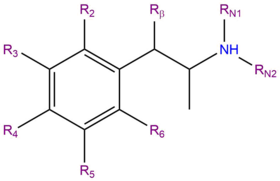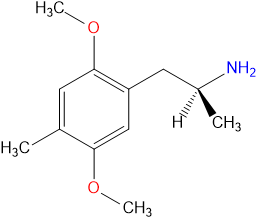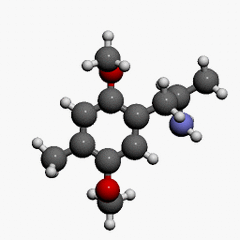DOM: Difference between revisions
>Oskykins m Text replace - "Perspectives" to "Alterations in perspective" |
>Oskykins m Text replace - "Autonomous entities" to "Autonomous entities" |
||
| Line 86: | Line 86: | ||
DOM produces a full range of high level hallucinatory states in a fashion that is more consistent and reproducible than that of many other commonly used [[psychedelics]]. This holds particularly true in comparison to other substances within the [[phenethylamines|phenethylamine]] family. These effects include: | DOM produces a full range of high level hallucinatory states in a fashion that is more consistent and reproducible than that of many other commonly used [[psychedelics]]. This holds particularly true in comparison to other substances within the [[phenethylamines|phenethylamine]] family. These effects include: | ||
*'''[[Visual effects: Transformations|Transformations]]''' | *'''[[Visual effects: Transformations|Transformations]]''' | ||
*'''[[Visual effects: Internal hallucinations|Internal hallucinations]]''' (''[[ | *'''[[Visual effects: Internal hallucinations|Internal hallucinations]]''' (''[[Visual effects: Autonomous entities|Autonomous entities]]'', ''[[Visual_effects:_Internal_hallucinations#Settings|Settings]]'',''[[Visual effects: Alterations in perspective|Alterations in perspective]]'' and ''[[Visual_effects:_Internal_hallucinations#Scenarios|Scenarios]]'') - In comparison to other psychedelics such as [[LSD]], DOM is extremely high in its internal hallucinations. This particular effect commonly contains hallucinations with scenarios, settings, concepts and autonomous entity contact. they can be comprehensively described in terms of their [[Visual_effects:_Internal_hallucinations#Variations|variations]] as lucid in believability, interactive in style, new experiences in content, autonomous in controllability and [[Visual effects: Geometry|geometry]] based in appearance. They are more common within dark environments and can be described as internal in their manifestation, lucid in believability, interactive in style and almost exclusively of religious, spiritual, mystical or a transcendental nature in their overall theme. | ||
===Auditory effects=== | ===Auditory effects=== | ||
Revision as of 05:26, 17 June 2014
2,5-Dimethoxy-4-methylamphetamine (DOM) or STP is a psychedelic drug of the substituted phenethylamine and substituted amphetamine chemical classes. It is a member of the DOx family of compounds.
DOM was first synthesized and tested in 1963 by Alexander Shulgin who was investigating the effect of 4-position substitutions on psychedelic amphetamines.[1] It has a very limited history of human usage prior to the 1991 publication of its synthesis and pharmacology in PiHKAL (Phenethylamines i Have Known And Loved).[2] by Alexander Shulgin. In modern times, it is used as a recreational drug and an entheogen, rarely sold on the streets and almost exclusively obtained as a grey area research chemical through the use of online vendors.
DOM is a highly dose sensitive psychedelic that is often sold on blotting paper and known for its strong visuals and intense body load. Many reports also indicate that the effects of this chemical may be overly intense for those who are not already experienced with psychedelics.
Chemistry

DOM is a substituted alpha-methylated phenethylamine, a class of compounds commonly known as amphetamines. [3] The phenethylamine equivalent (lacking the alpha-methyl group) is 2C-D.
Pharmacology
DOM is a selective 5-HT2A, 5-HT2B, and 5-HT2C receptor partial agonist. Its psychedelic effects are mediated by its agonistic properties at the 5-HT2A receptor. Due to its selectivity, DOM is often used in scientific research when studying the 5-HT2 receptor subfamily.
DOM is a chiral molecule, and R-(-)-DOM is the more active enantiomer, functioning as a potent agonist of the serotonin 5-HT family of receptors; mainly of the 5-HT2 subtype.[4]
Subjective effects
The effects listed below are based upon the subjective effects index and personal experiences of PsychonautWiki contributors. The listed effects will rarely if ever occur all at once but heavier dosages will increase the chances and are more likely to induce a full range of effects.
Physical effects
The physical effects of DOM can be broken down into six components all of which progressively intensify proportional to dosage. These are described below and generally include:
- Spontaneous tactile sensations - The "body high" of DOM is manifested as somewhat intense in comparison to most classical psychedelics, however in comparison to DOC and the overwhelming forcefulness of 2C-E, it can actually be considered quite mild. The sensation itself can be described as a constantly present yet somewhat mild energetic pins and needles sensation that encompasses a person’s entire body. This is coupled with a euphoric, fast moving, sharp and location specific tingling sensation. It is usually felt over every square inch of the skin but occasionally manifests itself in the form of a continuously shifting tingling sensation that travels up and down the body in spontaneous waves.
- Stimulation - In terms of its effects on the physical energy levels of the tripper, DOM is usually considered to be extremely stimulating at levels which do not become overwhelming, resulting in a shakiness and unsteadiness of the hands but encouraging trippers to move around, run, dance, climb and generally engage in physical activities. In comparison, other more commonly used psychedelics such as psilocin are generally sedating and relaxed.
- Enhancement of touch - Feelings of enhanced tactile sensation are consistently present at moderate levels throughout most DOM trips. Once Level 8A visuals are reached, an intense sensation of suddenly becoming aware of and being able to feel every single nerve ending across a person's entire body all at once is consistently present.
- Nausea - Mild to extreme nausea are reported when consumed in moderate to high dosages and either passes once the tripper has vomited or gradually fades by itself as the peak sets in.
- Vasoconstriction - This effect is usually only present at higher dosages but can be particularly uncomfortable.
- Increased bodily control
Cognitive effects
The cognitive effects of DOM are described by many as a combination of extreme mental stimulation and a powerful enhancement of a person's current mental state.
The total sum of these cognitive components regardless of the setting generally includes:
- Increased empathy, love and sociability - This component is consistently manifested only in the context of social settings in which one is within the company of others. These feelings of sociability, love and empathy are a little weaker and less sharp than those found on substances such as MDMA and 2C-B but still prove strong enough to provide long lasting therapeutic effects.
- Introspection - This component is consistently manifested only in the context of a non-social setting in which the user is alone.
- Acceleration of thought
- Time distortion
- Feelings of fascination, importance and awe
- Conceptual thinking
- Connectivity of thought
- Enhancement of current mind state
- Removal of cultural filter
- Ego suppression, loss and death
Visual effects
Enhancements
DOM presents a full and complete array of possible visual enhancements which generally includes:
Distortions
As for visual distortions and alterations, the effects experienced are detailed below:
- Drifting (Melting, Flowing, Breathing and morphing) - In comparison to other psychedelics, this effect can be described as highly detailed, slow and smooth in motion, static in their appearance and unrealistic/cartoon-like in style.
- Tracers
- After images
- Texture repetition
- Colour shifting
- Scenery slicing
The visual geometry that is present throughout this trip can be described as more similar in appearance to that of 4-AcO-DMT, Ayahuasca than that of LSD, 2C-B or 2C-I. It can be comprehensively described through its variations as intricate in style, equally algorithmic and abstract in form, equally synthetic and organic in style, structured in organization, brightly lit in lighting, multicoloured in scheme, glossy in shading, sharp in edges, large in size, fast in speed, smooth in motion, equal in rounded and angular corners, unimmersive in depth and consistent in intensity. At higher dosages are significantly more likely to result in states of Level 8A visual geometry over Level 8B.
Hallucinatory states
DOM produces a full range of high level hallucinatory states in a fashion that is more consistent and reproducible than that of many other commonly used psychedelics. This holds particularly true in comparison to other substances within the phenethylamine family. These effects include:
- Transformations
- Internal hallucinations (Autonomous entities, Settings,Alterations in perspective and Scenarios) - In comparison to other psychedelics such as LSD, DOM is extremely high in its internal hallucinations. This particular effect commonly contains hallucinations with scenarios, settings, concepts and autonomous entity contact. they can be comprehensively described in terms of their variations as lucid in believability, interactive in style, new experiences in content, autonomous in controllability and geometry based in appearance. They are more common within dark environments and can be described as internal in their manifestation, lucid in believability, interactive in style and almost exclusively of religious, spiritual, mystical or a transcendental nature in their overall theme.
Auditory effects
The auditory effects of DOM are common in their occurrence and exhibit a full range of effects which commonly includes:
Toxicity and Harm Potential
The toxicity and long term health effects of recreational DOM has limited research in a scientific context. This is because DOM is a research chemical with very little history of human usage. Anecdotal evidence from people who have tried DOM within the psychedelic community suggests that there are no negative health effects attributed to simply trying this drug at low to moderate doses or using it very sparingly (but nothing can be completely guaranteed).
Tolerance and Addiction Potential
DOM is not physically addictive and many users experience a frequency self-regulating quality to the drug. Tolerance for DOM seems to be very mild and does not build up without repeated use over a short period of time.
Legal Issues
- UK: DOM is a Class A drug.
- USA: DOM is a Schedule I drug.
- Canada: DOM is a Schedule I drug.
- New Zealand: DOM is a Class C drug.
- Belgium: DOM is a Schedule I drug.
See Also
References
- ↑ Shulgin, Alexander (1991). Pihkal : a chemical love story. Berkeley, CA: Transform Press. pp. 53–56.
- ↑ http://www.erowid.org/library/books_online/pihkal/pihkal.shtml
- ↑ http://books.google.com/books?id=gvanBNhSQ5YC&pg=PA157&lpg=PA157&dq=DOM+is+a+substituted+alpha-methylated+phenethylamine,&source=bl&ots=QBm-rgNHFs&sig=cOGzSnEkZP--IEpEJZQLldyoxwc&hl=en&sa=X&ei=gIfUUrL3IbPRsASMnIH4Cw&ved=0CF4Q6AEwBg#v=onepage&q=DOM%20is%20a%20substituted%20alpha-methylated%20phenethylamine%2C&f=false
- ↑ Sanders-Bush, Burris, KD; Knoth, K, (September 1988). "Lysergic acid diethylamide and 2,5-dimethoxy-4-methylamphetamine are partial agonists at serotonin receptors linked to phosphoinositide hydrolysis" http://www.ncbi.nlm.nih.gov/pubmed/2843634

